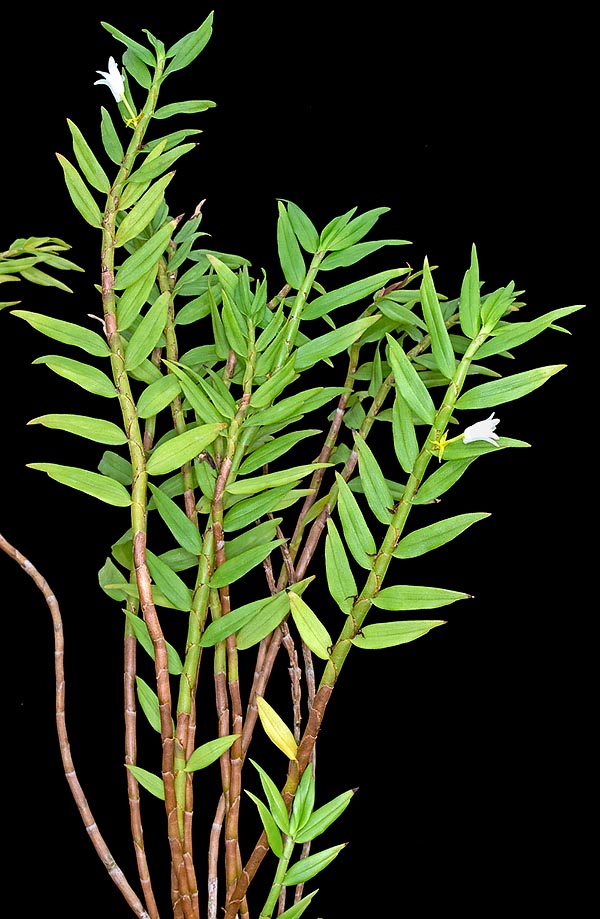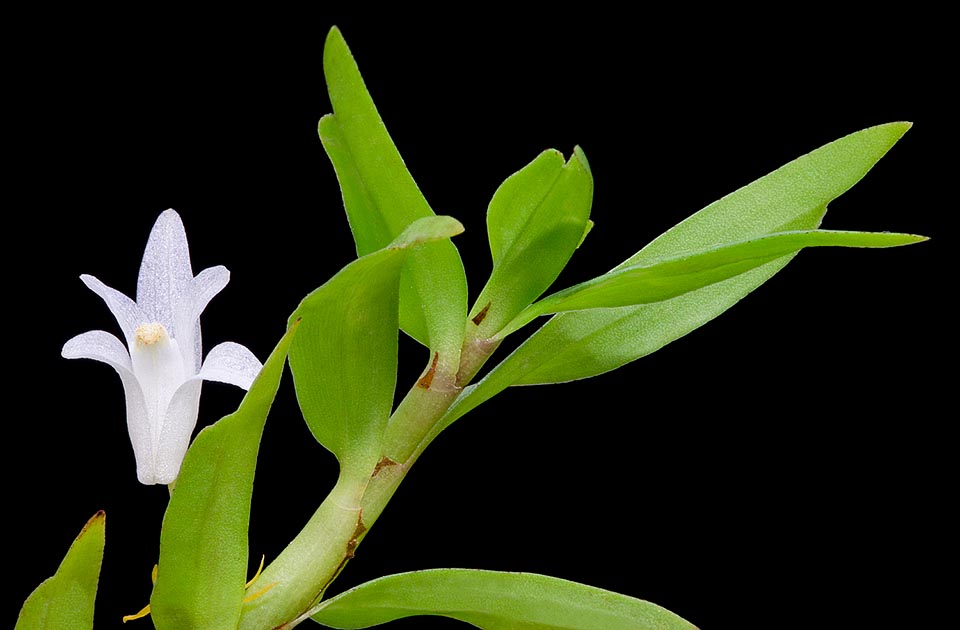Family : Orchidaceae

Text © Pietro Puccio

English translation by Mario Beltramini

The Eria pilifera is a cespitous epiphyte, with 40-50 cm cylindrical pseudobulbs, native to South-East Asia © Giuseppe Mazza
The name of the genus comes from the Greek substantive “ἔριον” (erion) = wool, with reference to the down present in many species; the specific name is the combination of the Latin substantive “pilus, i” = hair and of the verb “fero” = to carry, with reference to the short hair covering the median lobe of the labellum.
Common names: ueang nim kap dok lueang (Thai).
The Eria pilifera Ridl. (1896) is an epiphytic species that forms dense tufts with cylindrical pseudobulbs slightly compressed laterally, 40-50 cm long, provided for almost all the length of alternate leaves, distichous, lanceolate with iregularly bilobed apex, 7-8 cm long and 1-1,2 cm broad, all facing the same side, of pale green colour.
Racemose inflorescences opposite to the leaves with few (2-4) white flowers, produced one at a time, of about 1,7 cm of diameter, subtended by 3-4 persistent lanceolate bracts, pubescent, 0,3-0,5 mm long, of pale yellow to orange colour; ovary and pedicel of yellow colour, pubescent, about 1 cm long. Oblong lanceolate sepals with subacute apex, 1-1,1 cm long and 0,4-0,5 cm broad, the lateral united at the base to form a spur with obtuse apex, about 0,3 cm long. Lanceolate petals with sub-acute apex, about 0,8 cm long and 0,3 cm broad, trilobed labellum, 0,7-0,8 cm long and 0,7 cm broad, with erect lateral lobes with rounded apex, at the sides of the column, and ovate median lobe, about 0,25 cm long and broad, covered by a short down of lemon yellow to orange yellow colour, and about 0,4 cm long column.
It reproduces by seed, in vitro, and by division, with each section provided of at least 3-4 pseudobulbs, to be done at the vegetative restart.
Miniature orchid diffused in a vast area of South-East Asia, but little known elsewhere, requires a cultivation location slightly shaded and aerated, medium-high temperatures, 20-32 °C, and high humidity, 70-85 %. Frequent waterings during the growth of the pseudobulbs in order to maintain constantly humid the substratum, then more spaced, but without allowing it to dry up completely, until the vegetative restart. Due to the dimensions it can reach it is better to cultivate it in pots or baskets with draining and aerated compost that may be formed by medium sliced bark fragments with possible addition of sphagnum at the base of the plant if the cultivation site is rather dry.

Alternate 7-8 cm leaves. Small little flowers of 1,7 cm of diameter subtended by 3-4 persistent lanceolate 0,3-0,5 mm bracts, yellowish or orange © Giuseppe Mazza
Synonyms: Dendrobium lamonganense Rchb.f. (1857); Trichotosia bracteolata Kraenzl. (1910); Trichotosia pilifera (Ridl.) Kraenzl. (1911); Eria bracteolata (Kraenzl.) Ames (1914); Cylindrolobus pilifer (Ridl.) Rauschert (1983).
→ For general notions about ORCHIDACEAE please click here.
